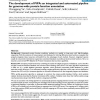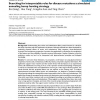1065 search results - page 110 / 213 » Predicting Peroxisomal Proteins |
BMCBI
2007
13 years 8 months ago
2007
Background: Protein remote homology detection is a central problem in computational biology. Most recent methods train support vector machines to discriminate between related and ...
BMCBI
2008
13 years 8 months ago
2008
Background: Automated protein function prediction methods are needed to keep pace with high-throughput sequencing. With the existence of many programs and databases for inferring ...
JCB
2006
13 years 8 months ago
2006
Protein fold recognition is an important step towards understanding protein three-dimensional structures and their functions. A conditional graphical model, i.e., segmentation con...
BMCBI
2006
2006
Searching for interpretable rules for disease mutations: a simulated annealing bump hunting strategy
13 years 8 months ago
Background: Understanding how amino acid substitutions affect protein functions is critical for the study of proteins and their implications in diseases. Although methods have bee...
RECOMB
2006
Springer
14 years 8 months ago
2006
Springer
Abstract. We describe and empirically evaluate machine learning methods for the prediction of zinc binding sites from protein sequences. We start by observing that a data set consi...


